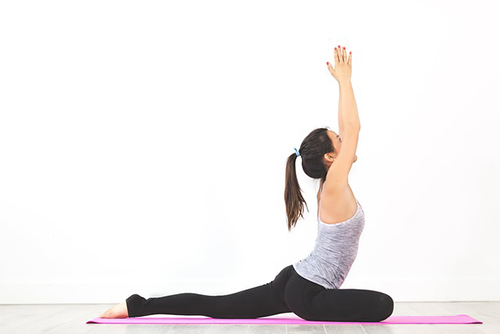A pinched nerve in the shoulder is incredibly aggravating. It can hamper day-to-day activities, awaken you in the dead of night, and just cause problems.
There are many stretches that can help a pinched nerve in the shoulder. The following list of seven such stretches and types of stretches are a good place to start.
- Chin Tucks
- Head Turns
- Shoulder Rolls
- Side Bends
- Neck Tilts
- Sliding Towel Stretch
- Yoga Poses
Using these stretches, you may be able to relieve the pain of a pinched nerve in your shoulder.
Let’s take a closer look.
One of the first things many chiropractors do for an individual suffering from a pinched nerve in the shoulder will be to recommend a series of stretches and possible exercises for the patient. If you are careful, you can try these stretches yourself, but if you have any doubts, seek professional assistance.
Here is a small compilation of some stretches you can use to alleviate pain caused by a pinched nerve in the shoulder. Remember, though, if any stretch or exercise you use results in an increase in pain or other negative symptoms, contact a chiropractor or physical therapist immediately.
1. Chin Tucks
While standing straight, pull your chin back (or gently push it back with your fingers, if required) and then lower it slightly. Hold for several seconds and then repeat five times.
2. Head Turns
While standing straight and looking forward, slowly turn your head to the side (right or left) as far as possible without causing pain. Hold for about 10 seconds and then repeat on the other side.
3. Shoulder Rolls
Stand straight and lift both shoulders towards your ears, then, while lowering them down gently, push them backward. Repeat, but instead of pushing backward, push forward. Do five sets.
4. Side Bends
Clasp your hands above your head while standing straight and tall. Gently bend from side to side without arching your back. Repeat up to ten times.
5. Neck Tilts
While standing or sitting, tuck your chin in toward your neck. Pull your chin up and back to feel the stretch. Then, carefully raise your head so as to look at the ceiling. Do up to five sets.
6. Sliding Towel Stretch
For a pinched nerve on the left shoulder, grasp the end of a towel with your left hand. Lift your left hand up and behind your head so as to drape the towel across your back. Reach around your back and grab the other end of the towel with your right hand. Gently pull up with the left hand and then pull down with the right. Repeat several times. If the nerve pinch is on the right side, reverse hands.
7. Yoga Poses
There are a number of different yoga poses that can help with pinched nerves throughout the body. One good one for the shoulder is the pose called Child’s Pose. For this pose, begin by kneeling and sitting on the heels of your feet with the top parts of your feet pressed against the mat. Gently fall forward and lay your chest and head flat against the ground with your arms over your head or, rather, crossed in front of your face. Hold for approximately 30 seconds.
In addition to Child’s Pose, there are a number of other poses from yoga that may be able to help with pinched nerve relief. These include:
- Seated Mountain Pose
- Cow Face Arms
- Ear to Shoulder
- The Baby Cobra
Yoga is a popular pastime and its methods of stretching are very effective at relieving nerve pinches in the shoulder and elsewhere.
In addition to stretches, there are a few exercises you can try. If you are suffering from a pinched nerve in the neck, I also wrote a blog post about cervical radiculopathy exercises you should try.
Pinched Nerves and Chiropractic Care
First, let’s look at a few cases where Chiropractic Care was used to treat pinched nerves in the shoulder area (note: many pinched nerves in the shoulder originate in the neck).
A case study on Science Direct from the Journal of Chiropractic Medicine describes the case of a 64-year old man suffering from pain radiating from the C6/C7 vertebra into his neck and shoulder. This case demonstrates a successful treatment of the pain through the use of a chiropractic technique called Cox flexion-distraction: “The patient reported being pain-free and fully functional 8 months following the conclusion of care.” (1)
Another case report, again from The Journal of Chiropractic and again listed on Science Direct, demonstrates how a series of chiropractic treatments “consisting of manipulation, soft tissue mobilizations, exercise, and education of workstation ergonomics appeared to reduce the symptoms of ulnar nerve compression symptoms” in a 41-year-old woman. (2)
Another case report from the The Journal of the Canadian Chiropractic Association “chronicles the successful management of a 55-year-old patient diagnosed with cervical radiculopathy using spinal manipulative therapy and cervical paraspinal post-isometric relaxation stretches.” (3)
Realize, of course, that cervical radiculopathy is often the root cause of what many people call a pinched nerve in the shoulder.

Exercises for Shoulder Strength
If stretching alone doesn’t work well enough, there are a number of exercises you can do to help build up the muscles involved so that they provide better support for the structures in the affected area. In this case, the shoulder. Recommended exercises include The Serratus Push, The Triceps Stretch, The Pectoralis Stretch, and External Shoulder Rotations.
Stretching and exercise are obvious first steps to take to help your shoulder. However, as stated above, if your self-treatment does not seem to be working, it’s a good idea to look into chiropractic care.
What Are the Signs of a Pinched Nerve in the Shoulder?
Pinched nerves are the terms used to describe a nerve that has been compressed or “pinched” by tissue around it that is pressing in upon it. Due to the nature of our nervous system, the pinching of a nerve in one location of the body may have effects somewhere else in the body. The source for a pinched nerve in the shoulder, for example, is often a nerve being compressed in the neck.
Typical symptoms of a pinched nerve in the shoulder include such unpleasant things as:
- Pain
- Tingling
- Numbness
- And weakness
Such issues can make moving your arm and shoulder difficult since such may cause pain. And in cases of weakness, trying to do even basic tasks can become problematic.
How Do You Release a Pinched Nerve in the Shoulder?
Suffering from a pinched nerve in the shoulder is hardly enjoyable. Sometimes the pain is so unbearable, you can barely stand, let alone move around. However, you are not totally at its mercy. There are some things you can do to help relieve your pain and release your pinched nerve.
First off, all the stretches and exercises we listed above can go a long way toward releasing a pinched nerve in your shoulder. In addition, there are a number of other conservative options you can try. These include things like:
- Rest: Rest is often a great option for many musculoskeletal issues. In the case of a shoulder, you want to refrain from moving your whole arm. You can put it in a sling or tape it to your side, if necessary. The goal is to give the nerve about 48 hours to calm down.
- Cold and Heat Therapy: This is another common treatment. It simply involves applying cold and heat compresses to the affected region on and off, alternating between hot and cold. Generally, you should start with an ice pack for 20 minutes, rest for 20 minutes, then switch to a heating pad for 20 minutes. Do this a few times per day and it should help reduce swelling, inflammation, and pain.
- Modify Your Sleeping Habits: Often pinched nerves make sleeping difficult; it’s hard to get comfortable and you suffer pain no matter what you do. However, you have a few options. Sleeping with radiculopathy or a pinched nerve in the shoulder can be made easier by sleeping on your back or on the side opposite to the affected shoulder. Basically you want to avoid putting pressure on the affected area.
As a general rule, if you try any of these methods and don’t find any relief after two days, it’s a good idea to contact your chiropractor or another medical professional. .
Conclusion
Chiropractors are experts in the musculoskeletal system and nervous system. If you feel the pinched nerve in your shoulder requires professional attention, a chiropractor is a great choice. They’ll be able to diagnose not only the condition but the cause of the condition, as well. From there, they’ll be able to design a treatment program for you.









